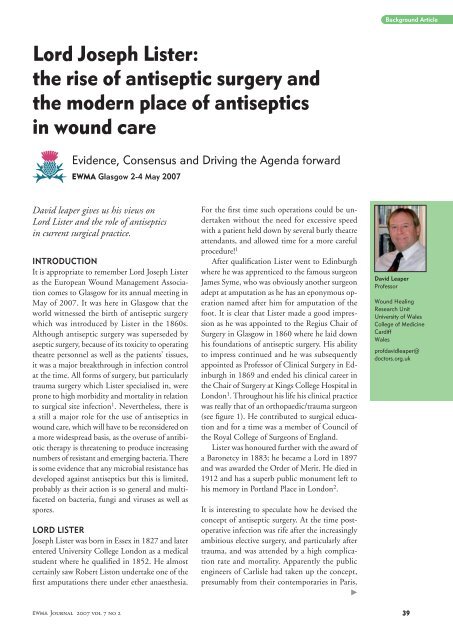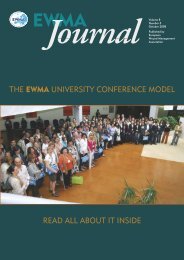You also want an ePaper? Increase the reach of your titles
YUMPU automatically turns print PDFs into web optimized ePapers that Google loves.
Lord Joseph Lister:<br />
the rise of antiseptic surgery and<br />
the modern place of antiseptics<br />
in wound care<br />
Evidence, Consensus and Driving the Agenda forward<br />
<strong>EWMA</strong> Glasgow 2-4 May 2007<br />
David leaper gives us his views on<br />
Lord Lister and the role of antiseptics<br />
in current surgical practice.<br />
INTRODUCTION<br />
It is appropriate to remember Lord Joseph Lister<br />
as the European Wound Management Association<br />
comes to Glasgow for its annual meeting in<br />
May of 2007. It was here in Glasgow that the<br />
world witnessed the birth of antiseptic surgery<br />
which was introduced by Lister in the 1860s.<br />
Although antiseptic surgery was superseded by<br />
aseptic surgery, because of its toxicity to operating<br />
theatre personnel as well as the patients’ tissues,<br />
it was a major breakthrough in infection control<br />
at the time. All forms of surgery, but particularly<br />
trauma surgery which Lister specialised in, were<br />
prone to high morbidity and mortality in relation<br />
to surgical site infection 1 . Nevertheless, there is<br />
a still a major role for the use of antiseptics in<br />
wound care, which will have to be reconsidered on<br />
a more widespread basis, as the overuse of antibiotic<br />
therapy is threatening to produce increasing<br />
numbers of resistant and emerging bacteria. There<br />
is some evidence that any microbial resistance has<br />
developed against antiseptics but this is limited,<br />
probably as their action is so general and multifaceted<br />
on bacteria, fungi and viruses as well as<br />
spores.<br />
LORD LISTER<br />
Joseph Lister was born in Essex in 1827 and later<br />
entered University College London as a medical<br />
student where he qualified in 1852. He almost<br />
certainly saw Robert Liston undertake one of the<br />
first amputations there under ether anaesthesia.<br />
<strong>EWMA</strong> Journal 2007 vol 7 no 2<br />
For the first time such operations could be undertaken<br />
without the need for excessive speed<br />
with a patient held down by several burly theatre<br />
attendants, and allowed time for a more careful<br />
procedure! 1<br />
After qualification Lister went to Edinburgh<br />
where he was apprenticed to the famous surgeon<br />
James Syme, who was obviously another surgeon<br />
adept at amputation as he has an eponymous operation<br />
named after him for amputation of the<br />
foot. It is clear that Lister made a good impression<br />
as he was appointed to the Regius Chair of<br />
Surgery in Glasgow in 1860 where he laid down<br />
his foundations of antiseptic surgery. His ability<br />
to impress continued and he was subsequently<br />
appointed as Professor of Clinical Surgery in Edinburgh<br />
in 1869 and ended his clinical career in<br />
the Chair of Surgery at Kings College Hospital in<br />
London 1 . Throughout his life his clinical practice<br />
was really that of an orthopaedic/trauma surgeon<br />
(see figure 1). He contributed to surgical education<br />
and for a time was a member of <strong>Council</strong> of<br />
the Royal College of Surgeons of England.<br />
Lister was honoured further with the award of<br />
a Baronetcy in 1883; he became a Lord in 1897<br />
and was awarded the Order of Merit. He died in<br />
1912 and has a superb public monument left to<br />
his memory in Portland Place in London 2 .<br />
It is interesting to speculate how he devised the<br />
concept of antiseptic surgery. At the time postoperative<br />
infection was rife after the increasingly<br />
ambitious elective surgery, and particularly after<br />
trauma, and was attended by a high complication<br />
rate and mortality. Apparently the public<br />
engineers of Carlisle had taken up the concept,<br />
presumably from their contemporaries in Paris,<br />
�<br />
Background Article<br />
David Leaper<br />
Professor<br />
Wound Healing<br />
Research Unit<br />
University of Wales<br />
College of Medicine<br />
Cardiff<br />
Wales<br />
profdavidleaper@<br />
doctors.org.uk

















